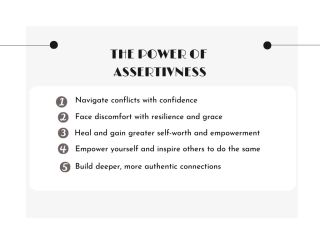
Assertiveness training develops a powerful relational skill set that can significantly enhance confidence, communication, and happiness in interpersonal relationships. By learning to think and act assertively, you can overcome fear, improve your ability to handle challenging situations, and foster stronger connections with others. Assertive behavior strikes a balance between being passive and aggressive, allowing you to advocate for yourself while respecting others.
Passive Behavior: The “You Win, I Lose” Method
Passive behavior prioritizes the needs and goals of others over your own, often leading to avoidance, submissiveness, or fearfulness. People who are passive or nonassertive may struggle to express their thoughts or needs, resulting in feelings of resentment, low self-esteem, and dissatisfaction in relationships.
Key Characteristics of Passive Behavior
- Avoidance and withdrawal
- Timidity and deference
- Indirect or inactive communication
Passive individuals may also use indirect methods of control, such as withdrawing, spreading rumors, or refusing to cooperate. These passive-aggressive behaviors can undermine relationships and prevent the resolution of conflicts.
Consequences of Passiveness
- Loss of control and autonomy
- Accumulated resentment in relationships
- Decreased self-esteem and confidence
To break free from passiveness, it’s crucial to develop assertive communication skills and to foster a mindset that values your needs and boundaries.
Aggressive Behavior: The “I Win, You Lose” Method
Aggressive behavior focuses on personal needs and goals at the expense of others, often disregarding their needs or feelings. While it may appear confident, aggression damages relationships and creates a climate of selfishness, fear or resentment.
Key Characteristics of Aggressive Behavior
- Domination and manipulation
- Dishonesty and disregard for others’ boundaries
- Intimidation through physical, verbal, or emotional tactics
Aggressive individuals may employ manipulative strategies such as bullying, deception, or judgmental behavior to control others. These methods may provide short-term rewards, like gaining control, but they erode trust and intimacy over time.
Consequences of Aggression
- Strained or broken relationships
- Increased loneliness and mistrust
- Difficulty achieving genuine emotional connections
To move away from aggression, adopting assertive strategies can help foster mutual respect and understanding.
Assertive Behavior: The “Win-Win” Method
Assertiveness is the middle ground between passivity and aggression. It involves standing up for your needs and rights while respecting the needs and rights of others. This approach is rooted in honesty, empathy, and a commitment to finding solutions that benefit all parties involved.
Key Characteristics of Assertive Behavior
- Direct and honest communication
- Confidence paired with empathy
- A focus on mutual respect and collaboration
Assertive individuals seek to resolve conflicts constructively, using diplomacy and persuasion to achieve shared goals. This approach encourages deeper understanding and more meaningful connections.
Benefits of Assertiveness
- Improved communication and conflict resolution
- Increased self-esteem and confidence
- Stronger, more fulfilling relationships
Practical Tips for Developing Assertiveness
Understand Your Rights and Boundaries
- Value yourself. Recognize that you have the right to express your thoughts, feelings, and needs. Assertiveness begins with valuing your own perspective while respecting others.
Practice Honesty and Direct Communication
- Use “I” statements to express your feelings and needs. For example, “I feel overwhelmed when deadlines are unclear” is more assertive than blaming or passive silence.
Stay Calm and Focused
- In emotionally charged situations, take a moment to breathe and collect your thoughts. This helps you communicate effectively without resorting to aggression or retreating into passivity.
Use Empathy and Active Listening
- Listen to understand. Show genuine interest in others’ perspectives. Responding with empathy can de-escalate conflicts and pave the way for collaborative problem-solving.
Pay Attention to Nonverbal Communication
- Assertiveness isn’t just about words; nonverbal cues like posture, tone of voice, eye contact, and facial expressions significantly influence how messages are perceived. Guidance on using assertive body language can enhance communication.
Be Persistent, Not Pushy
- Assertiveness involves standing your ground without becoming overbearing. If you encounter resistance, calmly restate your position and remain open to dialogue.
Practice Healthy Boundaries
- Know and protect your boundaries and other people’s boundaries. To protect your boundaries, clearly and calmly communicate your needs and limits to others using direct, respectful language.
Accept What Is Beyond Your Control
- Accept that you can’t control other people. Aspire to influence others with respect and gentleness, rather than being forceful.
Set Realistic Goals
- Start by practicing assertiveness in low-stakes situations, such as expressing a preference or asking for clarification. Gradually apply these skills to more challenging scenarios.
Handle Criticism Assertively
- Assertiveness involves responding constructively to criticism without becoming defensive or passive. Techniques for reframing criticism as feedback could be included.
Balance Assertiveness With Flexibility
- While standing firm on core values is vital, assertiveness also involves knowing when to compromise for the greater good. This balance prevents assertiveness from veering into rigidity.
Seek Feedback and Reflect
- Ask trusted friends or mentors for feedback on your communication style. Reflect on past interactions to identify areas for improvement.
The Long-Term Rewards of Assertiveness
Assertiveness is a skill that requires practice and persistence, but the rewards are profound. Assertive individuals experience greater satisfaction in their relationships, careers, and personal lives. They are more likely to achieve their goals while fostering mutual respect and understanding with others.
By embracing assertiveness, you can:
- Navigate conflicts with confidence
- Build deeper, more authentic connections
- Empower yourself and inspire others to do the same
Remember, assertiveness is not about “winning” over others—it’s about creating a balanced, respectful approach that benefits everyone involved.
Conclusion
Assertiveness training is a powerful tool for personal and interpersonal growth. By understanding the differences between passive, aggressive, and assertive behaviors, and practicing key assertive skills, you can transform your communication style and relationships. Start small, be consistent, and watch how your assertiveness reshapes your interactions and enriches your life. Whether at work, with friends, or in intimate partnerships, assertiveness empowers you to be confident, competent, and compassionate.
